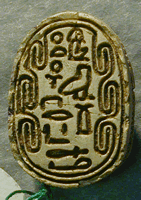| Homepage | Timeline | Maps | A-Z index | Learning |
Section 1: continuity or change?
Late Middle Kingdom personal naming and
administrative titles demonstrate extreme precision not matched in other periods,
including early Middle Kingdom, Second Intermediate Period, and start of Dynasty
18. Does this reflect changes in administration, or in the source record?
For late Middle Kingdom administration, the source record is dominated by three groups of material:
- the hieroglyphic inscriptions (above all Abydos stelae and, for Dynasty 12, quarry inscriptions)
- the hieratic documents (the Lahun papyri, and the court accounts document Papyrus Boulaq 18)
- name and title scarabs
The first two evaporate after mid- Dynasty
13, and the third undergoes fundamental change, as explored in this paper.
Section 2: name and title scarabs
Scarabs offer an object category in continuous
and substantial production through these periods: name and title scarabs are
attested in bulk from late Middle Kingdom and Second Intermediate Period.
The large corpus of late Middle Kingdom names and titles securely attested
on hieroglyphic stelae and hieratic documents provides guidance in distinguishing
groups of signs recording names and titles, from groups of signs in non-linguistic
arrangement.
Spectrum
from phonetic to visual content intended for hieroglyphs on scarabs
Hieroglyphs have a visual as well as a phonetic force, and are often found on scarabs in symmetrical arrangements which cannot be read as a linguistic sequence. In the spectrum from linguistic to non-linguistic arrangements, three zones may be identified:
(1) Groups of hieroglyphs that can be read as a phrase
(2) Groups of hieroglyphs that can be read as a name (and title), of a king or other person
(3) Groups of hieroglyphs selected as signs of amuletic power, not intended
as a linguistic sequence
Between Zones 1 and 2 there are phrases
that might be names, particularly kings' throne names, as these were themselves
phrases expressing some aspect of the cult of Ra. It is not always possible
to be sure that a particular instance of a phrase on a scarab was intended
as a throne name, even when the name is attested securely from other sources.
Between Zones 2 and 3, there are numerous examples of name and title scarabs with additional hieroglyphs selected for their symbolic force: the Martin 1971 corpus identified in particular the signs ka, nefer, wah, shen and bener. It is not always possible to be sure that a sign is part of a name or an amuletic supplement.
Zone 1: scarabs with hieroglyphs that can be read as a phrase
(not attested before late Second Intermediate
Period?)
Between Zones 1 and 2: scarabs with phrase, not necessarily a name
UC 11608 swAD.n-ra - is this the throne-name
of Nebiryerau? Or a
broader phrase invoking Ra (he whom Ra has caused to flourish)?
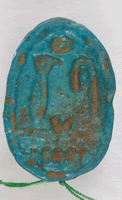
Zone 2: scarabs with name and title, without additional hieroglyphs:
|
UC 11337 scribe of the main enclosure
Sasobek back-type 6
|
UC 11480 director of the palace Ahau
(or Wiau?) back-type 6
|
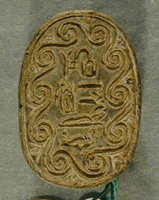 |
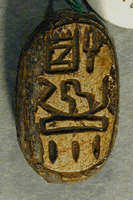 |
Between Zones 2 and 3: scarabs with name and title, with additional hieroglyphs for amuletic effect (e.g. UC 11203)
|
UC 28846 Koptos
|
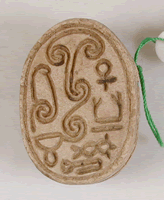 |
UC 11185 Green jasper scarab crudely incised with scratchmarks legible from the secure name and title corpus as imy-r w Sobeknakht
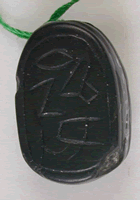
UC 11459 steatite scarab with neatly cut hieroglyphs starting sbk ending nb imAx but not easily readable as a name and title (Martin 1971: no.815 suggests rn-Htp as name, xt n pr-sbk as title, but neither is attested elsewhere)
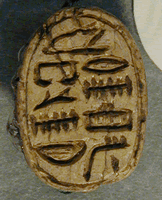
UC 11482 Martin 1971, no.654 but perhaps re-read gnwty kms with amuletic nfr and ankh? - note that the material is limestone, highly unusual in scarab production. Perhaps this is then a work by the sculptor (gnwty) outside regular scarab production.
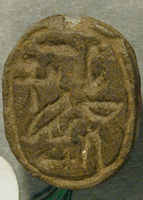
UC 11512 Martin 1971: no.1167, back-type 10: title imy-r gs (or 3hwt?) name hdwi-k3? Seems unlikely - the most disconcerting feature of the inscription, as compared with the rest of the Martin corpus, is the blank space at upper right centre - is this item an ancient scarab?
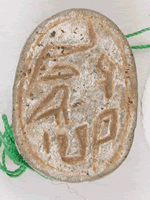
Note Martin 1971: no.814, a scarab formerly in the Matouk (ex-Blanchard) collection, tentatively read as a name rn-m-wnm, but with the note 'perhaps not a private-name seal' - back-type 10, ladder-side base design
Seals
and amulets: two categories
In papyrus Lahun UC 32179 verso, columns 2-3 of a list of commodities, there is the entry xtm n st 'seal of a woman' (below right), and the entries xtm and Hmyt 'seal' and 'cut stone' (below left).
The first might be taken to refer to a scarab-seal bearing the name of a woman. However the Egyptian phrase is not 'seal of name', but 'seal of woman' - it could be gendered in another way (material, motif, or simply ownership).
Clearly in ancient Egypt, all seals are also amulets: however, the Lahun papyrus demonstrates the existence of the two categories distinctly side by side
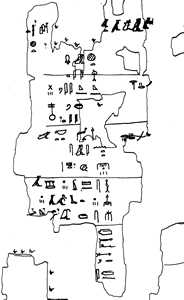 |
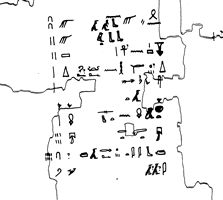 |
One possible form designed for sealing, over and above any amuletic use:
Shield shaped seals, usually administrative, some with personal name and title
Example UC 11340 officer of the town regiment Sobeknakht
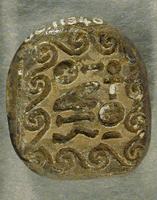
On
the root khetem
Possible connection between Semitic speakers and root xtm (vocalised 'khetem') 'seal' already in mid-D13:
UC 11379 Keeper of the sealed room Aperbaal (note Aper- name, found elsewhere with Asiatic deities, and the appearance of the Asiatic deity/word Baal)
Note the prominence of treasurers in the Second Intermediate Period record - however, it should be noted that the reading of the seal-sign as xtm in the title imy-r xtmt 'treasurer' remains uncertain
